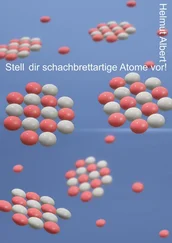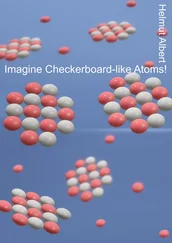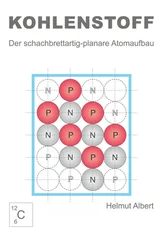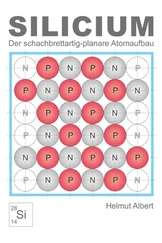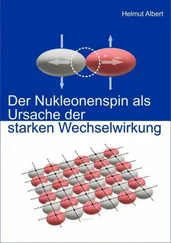SILICON
The checkerboard-like planar
atomic structure. No. 1.
Helmut Albert
Imprint
Cover picture: Silicon-28 atom
Responsible person: Helmut Albert, Talstraße 63,
79102 Freiburg / Germany
E-mail: hm.albert@t-online.de
Text and illustrations:
© Copyright Helmut Albert 2021
Printed by: epubli - a service of Neopubli GmbH, Berlin
Preliminary remarks
This e-book is the digitised edition of the paper with the same title already published as a print book. Changes have been made insofar as they were necessary for the e-book format. The translation from German was done with DeepL Pro.
Science and research are currently in the process of discovering more and more two-dimensional molecular structures of different elements. Although the detectable properties of the layered structures are hardly compatible with the idea of a core-shell atom, the outdated idea of electron orbitals is still held on to. A conception that has long been untenable due to numerous inconsistencies. The paper makes it clear that two-dimensional, molecular atomic layers must also have their basis in two-dimensionally constructed atoms. The checkerboard-like, planar atomic structure by protons and neutrons is the natural atomic structure that determines both the two- and the three-dimensional, molecular structures. The paper refers in parts to earlier publication by the author on the checkerboard-like-planar atomic structure. (cf. Albert 2017, 2019a, 2019b, 2021).
Helmut Albert, Freiburg, October 2021
1.0 Two-dimensional structures
Since the discovery and production of single-layer atomic layers of carbon, known as graphene, after the turn of the millennium, scientific interest in two-dimensional molecular structures has steadily increased worldwide. Particularly because people want to make these materials usable for the semiconductor industry. The most important material in the semiconductor industry to date is silicon, which forms hexagonal structures like carbon layers, but does not have the same advantageous properties of graphene. Numerous research projects are therefore aimed at further investigating the properties and molecular structures of silicon and making them usable.
At the end of 2020 and 2021, press releases from the Universities of Bonn and Heidelberg about "flat" and "two-dimensional" silicon compounds attracted attention. While researchers at the University of Bonn were able to produce and demonstrate the structure of a silicon compound as a flat trapezoid, researchers at the University of Heidelberg succeeded in building and demonstrating a square-planar arrangement. The press release of the University of Bonn states that the scientists were astonished by the "unusual stability" of the planar molecules and the University of Heidelberg reports that the scientists described the stability of the molecular configuration as a "surprise" (cf. Ebner, Greb 2021; Ghana et al. 2020); (University of Bonn 2020; University of Heidelberg 2021).
For the author of this paper, these experimental results are highly interesting, but not surprising; rather, they are confirmation of his theory of the checkerboard-like-planar atomic structure, which has been published in several papers since 2017. Already in the publication "Atomic model with checkerboard-like structure", one thesis is: The atomic structure is checkerboard-like and planar (Albert, Albert 2017: 21). Further publications were: "Theory of the planar and checkerboard structure of atomic rectangles" as well as the publication: "Imagine checkerboard-like atoms" 2021, with the illustration of the square-planar structure of the silicon isotope 28 and its valences. With the acceptance of this theory, a great advance in materials and semiconductor research would already be possible. As will be shown in the course of the paper, the theory and the atomic model already allow predictions to be made about most elements.
In order to substantiate this claim concretely, the following chapters explain the basics that contribute to a better understanding and calculability of the elements, using the silicon atom as an example. The proton-neutron configuration of the silicon atom is shown in detail. It is made clear why each proton and neutron site is important for the valence of an atom, which compounds silicon can form and what effect the mass number has on a silicon isotope.
In the paper, scientific fields such as physics and chemistry are combined and referred to as "science" for the sake of simplicity.
Конец ознакомительного фрагмента.
Текст предоставлен ООО «ЛитРес».
Прочитайте эту книгу целиком, купив полную легальную версию на ЛитРес.
Безопасно оплатить книгу можно банковской картой Visa, MasterCard, Maestro, со счета мобильного телефона, с платежного терминала, в салоне МТС или Связной, через PayPal, WebMoney, Яндекс.Деньги, QIWI Кошелек, бонусными картами или другим удобным Вам способом.


